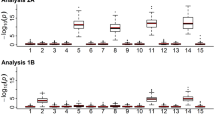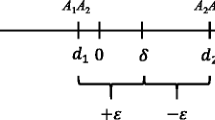Abstract
Genetic improvement schemes in livestock are based on the assumption that the expression of relevant genes is independent of parent of origin. Until now no evidence has been found to reject this assumption. The present study on three purebred pig populations, however, shows that a significant proportion of the phenotypic variance in backfat thickness (5–7%) can be explained by genes subject to paternal imprinting. The implication is that there are genes affecting backfat that are expressed only when derived from the paternal gamete. Paternal imprinted effects explained 1–4% of the phenotypic variation for growth rate. Maternal imprinted effects were heavily confounded with heritable maternal environmental effects. When modelled separately, these effects explained 2–5% and 3–4% of the phenotypic variance in backfat thickness and growth rate, respectively. Gametic imprinting may have consequences for the optimization of breeding programmes, especially in crossbreeding systems with specialized sire and dam lines.
Similar content being viewed by others
References
Barlow DP, Stöger R, Herrmann BG, Saito K, Swaifer N (1991) The mouse insulin-like growth factor type-2 receptor is imprinted and closely linked to the Tme locus. Nature 349:84–87
DeChiara TM, Efstratiadis A, Robertson EJ (1990) A growth deficiency phenotype in heterozygous mice carrying an insulin-like growth factor II gene disrupted by targeting. Nature 345:78–80
DeChiara TM, Robertson EJ, Efstratiadis A (1991) Parental imprinting of the mouse insulin-like growth factor II gene. Cell 64:849–859
Falconer DS (1989) Introduction to quantitative genetics, 3rd edn. Longman Scientific & Technical, Essex, UK
Graser H-U, Smith SP, Tier B (1987) A derivative-free approach for estimating variance components in animal models by Restricted Maximum Likelihood. J Anim Sci 64:1362–1370
Hall JG (1990) Genomic imprinting: review and relevance to human diseases. Am J Hum Genet 46:857–873
Henderson CR (1976) A simple method for computing the inverse of a numerator relationship matrix used in prediction of breeding values. Biometrics 32:69–83
Hofer A, Hagger C, Künzi N (1992) Genetic evaluation of on-farm tested pigs using an animal model. I. Estimation of variance components with restricted maximum likelihood. Livest Prod Sci 30:69–82
Kendall MG, Stuart A (1973) The advanced theory of statistics, vol. 2: inference and Relationship. Charles Griffin & Co, London
Lo LL, McLaren DG, McKeith FK, Fernando RL, Novakofski J (1992) Genetic analyses of growth, real-time ultrasound, carcass, and pork quality traits in Duroc and Landrace pigs: II. Heritabilities and correlations. J Anim Sci 70:2387–2396
Malcolm S, Clayton-Smith J, Nichols N, Robb S, Webb P, Armour JAL, Jeffreys AJ, Pembrey MA (1991) Uniparental paternal disony in Angelman's syndrome. Lancet 337:694–697
Meyer K (1989) Restricted maximum likelihood to estimate variance components for animal models with several random effects using a derivative-free algorithm. Genet Sel Evol 21:317–340
Meyer K, Hill WG (1992) Approximation of sampling variances and confidence intervals for maximum likelihood estimates of variance components. J Anim Breed 109:264–280
Nelder JA, Mead R (1965) A simplex method for function minimization. Comput J 7:147–151
Nicholls RD, Knoll JHM, Butler MG, Karam S, Lalande M (1989) Genetic imprinting suggested by maternal heterodisomy in nondeletion Prader-Willi syndrome. Nature 342:281–285
Reik W (1989) Genomic imprinting and genetic disorders in man. Trends Genet 5:331–336
Reik W, Collick A, Norris ML, Barton SC, Surani MA (1987) Genomic imprinting determines methylation of parental alleles in transgenic mice. Nature 328:248–251
Sapienza C, Peterson AC, Rossant J, Balling R (1987) Degree of methylation of transgenes is dependent on gamete of origin. Nature 328:251–254
Schaeffer LR, Kennedy BW, Gibson JP (1989) The inverse of the gametic relationship matrix. J Dairy Sci 72:1266–1272
Surani MA, Barton SC, Morris ML (1984) Development of reconstituted mouse eggs suggests imprinting of the genome during gametogenesis. Nature 308:548–550
Tier B, Sölkner J (1993) Analysing gametic variation with an animal model. Theor Appl Genet 85:868–872
Wilken TM, Lo LL, McLaren DG, Fernando RL, Dziuk PJ (1992) An embryo transfer study of reciprocal cross differences in growth and carcass traits in ‘Duroc’ and ‘Landrace’ pigs. J Anim Sci 70:2349–2358
Author information
Authors and Affiliations
Additional information
Communicated by L.D. Van Vleck
Present address: On leave at AGBU as collaborator via fellowship under OECD project on Biological Resource Management
Rights and permissions
About this article
Cite this article
de Vries, A.G., Kerr, R., Tier, B. et al. Gametic imprinting effects on rate and composition of pig growth. Theoret. Appl. Genetics 88, 1037–1042 (1994). https://doi.org/10.1007/BF00220813
Received:
Accepted:
Issue Date:
DOI: https://doi.org/10.1007/BF00220813




